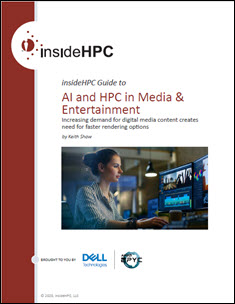 In this white paper sponsored by our friends over at Dell Technologies, we take a look at AI and HPC in Media & Entertainment where an increasing demand for digital media content creates need for faster rendering options.
In this white paper sponsored by our friends over at Dell Technologies, we take a look at AI and HPC in Media & Entertainment where an increasing demand for digital media content creates need for faster rendering options.
The ongoing increase in the use of visual effects (VFX) and computer-generated imagery (CGI) and animation in digital content media creation for television, movies, and streaming services has accelerated the amount of material that requires rendering, from a workstation to a data center render farm environment. Demands for digital media content creation that requires rendering include: new digital resolution requirements, demand for new media content, and new realities in working conditions for employees who are working from home require new hardware and networking solutions to address poor or limited bandwidth in residential areas compared with in-office equipment.
This technology guide, insideHPC Guide to AI and HPC in Media & Entertainment, explores how the increasing demand for digital media content creates need for faster rendering options.
Serving and Streaming Requirements
Once a piece of content is finished—for example, a TV episode for a streaming service, or a full length animated movie that has finished its theatrical run and is ready for distribution via on-demand platforms —different formats need to be created of the main file. Today’s consumer has several different choices on where they want to view media content—whether it’s on their mobile phone, tablet, gaming console, high- definition 4K TV, or on their laptop display. Within each of those devices, several manufacturers have different display size requirements for content creators to follow. In each case, a file needs to be created that matches resolution and display requirements for those devices.
In many cases, the process of creating those multiple files has been automated, but still requires compute to handle these jobs. In addition, a file doesn’t just sit on a centralized computer for thousands or millions of customers to access. Multiple copies of a file are distributed and cached on local or regional servers in order to provide a quick and seamless experience for the end customer who clicks play on a movie and expects the content to begin immediately. Any delay—whether it’s caused by an incorrectly formatted file, to bandwidth and latency due to heavy traffic—create an unhappy customer.
Requirements for Recommendation Engines
Streaming services aren’t just satisfied when a customer watches a single episode or movie—they want their customers to enjoy the full library of content available. Thus, they rely on accurate and speedy recommendations to best predict that if customers enjoyed one movie, they would also enjoy five or six others based on previous content watched.
Companies are now expanding AI methods to greatly accelerate the training of neural networks used to create better recommendation engines. Even with large data sets, a parallelization process that runs on high performance computing equipment can produce a faster training method than traditional machine learning techniques, which often take full days of training. With AI, better results come from larger data sets, which then require faster processing capabilities that high performance computing can offer.
Challenges for Content Creators
The creation of new digital content to meet audience demands, the need to duplicate and customize specific file formats for distribution, and the goal for better and faster recommendations through AI models are all driving demand for high performance computing through rendering farms and other server-based solutions.
In addition, smaller companies are looking to grow their rendering operations, moving from rendering on individual workstations or servers to a small server cluster, and are wondering how to accomplish this.
Complicating matters are new working conditions for many employees, who are now working from home due to pandemic-related lock-downs or other orders. While many companies have adopted virtual desktop infrastructure (VDI) approaches to allow workers to remotely access on-premise company workstations, problems related to poor bandwidth and latency have companies looking for different options for their workers. Adding to the problem are bandwidth demands from other people in the same residential neighborhood. Rendering a digital frame through a workstation connected to a rendering farm takes long enough, but now consider the time to do the same process over a virtualized connection with other network requests happening at the same time.
New Demands Require New Gear
The continuing growth of digital media and entertainment services, along with customer expectations for better CGI and VFX and higher resolution devices for viewing videos continue to place pressures on media studios and streaming platforms. Companies that can find ways to render content quickly and efficiently through new high performance computing clusters and rendering farms will be able to meet those demands to achieve a more successful outcome and keep their audiences entertained for years to come.
To learn more about how Dell Technologies can provide your company with high performance computing solutions across the digital media and entertainment content creation space, click here. See below for further references and additional reading.
Realize your potential with Dell EMC solutions for Media & Entertainment.
Over the last few weeks we have explored how the increasing demand for digital media content creates need for faster rendering options and how solutions from Dell can help streamline the process :
- Introduction
- The Rendering Process
- Serving and Streaming Requirements, Requirements for Recommendation Engines, Challenges for Content Creators, New Demands Require New Gear
Download the complete insideHPC Guide to AI and HPC in Media & Entertainment, courtesy of Dell.



